建筑项目管理概述
建筑工程项目管理

建筑工程项目管理建筑工程项目管理是指对建筑工程项目的全过程进行规划、组织、指挥、协调和控制,确保项目按时、按质、按量、按费用完成的管理活动。
它是一个综合性的工作,涉及到工程设计、施工、材料采购、质量控制、进度管理、成本控制等多个方面。
本文将从建筑工程项目管理的定义、重要性、主要内容和发展趋势等方面进行探讨。
一、建筑工程项目管理的定义建筑工程项目管理是指对建筑工程项目的全过程进行规划、组织、指挥、协调和控制,确保项目按时、按质、按量、按费用完成的管理活动。
它是一项涉及多方面工作的管理活动,需要协调项目各个环节之间的关系,确保项目能够顺利进行。
二、建筑工程项目管理的重要性建筑工程项目管理对于保证项目顺利进行、提高工程质量、控制工程成本、加强安全管理等方面具有重要意义。
首先,建筑工程项目管理可以确保项目按时完成,避免项目因为进度延误而导致的损失。
其次,它可以提高工程质量,通过统一的管理和控制,保证工程质量符合规定标准。
此外,建筑工程项目管理还可以控制工程成本,合理安排资源和材料,避免浪费和损失。
最后,它能够加强安全管理,确保工程施工过程中的安全,防止事故的发生。
三、建筑工程项目管理的主要内容建筑工程项目管理主要包括以下内容:1. 规划管理:制定项目目标和计划,确定项目各个阶段的任务和时间节点,确保项目可以按计划进行。
2. 组织管理:建立项目组织机构,明确各个岗位的职责和权限,确保项目组织结构的稳定和高效。
3. 指挥管理:负责对各个施工单位进行协调和指挥,确保施工过程中各个环节的协调和配合。
4. 协调管理:解决项目中出现的各种问题和矛盾,协调各个利益相关方的关系,确保项目的顺利进行。
5. 控制管理:对项目的进度、质量和成本进行控制,制定相应的管理措施,确保项目按预期目标实施。
6. 风险管理:对项目中可能出现的各种风险进行分析和评估,制定相应的防范措施,确保项目的顺利进行。
四、建筑工程项目管理的发展趋势随着科技的进步和社会的发展,建筑工程项目管理也在不断创新和发展。
建筑工程项目管理

建筑工程项目管理建筑工程项目管理是指在建筑工程建设的全过程中,通过科学、系统的组织和协调,以实现工程质量、进度和成本的控制为目标,保证工程项目的顺利进行和高效运作的管理活动。
本文将从工程项目管理的定义、重要性、主要任务和方法等方面进行阐述。
一、工程项目管理的定义工程项目管理是指通过计划、组织、协调、控制和评估等管理活动,对工程项目进行全面而系统的管理,以确保工程质量、进度和成本的目标得以实现。
在建筑工程项目中,项目管理是必不可少的环节,它涉及到工程项目从前期准备、设计、施工到竣工验收的各个环节,需要进行全过程的协调与管理。
二、工程项目管理的重要性1. 提高工程质量:合理的项目管理可以有效控制工程施工中的各个环节,确保合理的材料选用、工艺操作和施工质量,从而提高工程的质量水准。
2. 控制项目成本:项目管理可以合理调配资源,优化工程进度,降低材料成本、人力成本等费用,实现项目的经济效益最大化。
3. 确保工程安全:项目管理包括项目施工前期的风险评估和安全管理措施的制定,可以减少事故发生的概率,保障工程的施工过程安全无事故。
4. 提高工程进度:通过项目管理的方法和工具,可以有效的进行工程进度计划,提前发现问题并及时解决,以确保工程按期完成。
三、工程项目管理的主要任务1. 项目计划:制定详细的项目计划,确定项目的目标、任务和工期等要素,为项目的顺利进行提供指导和支持。
2. 资源管理:合理调配项目所需的各种资源,包括人力、物力、财力等,确保资源的合理利用和项目进展的顺利进行。
3. 进度控制:根据项目计划,制定具体的施工进度,并加强对施工进度的监督和控制,及时发现进展偏差并采取相应的措施进行调整。
4. 成本控制:对工程施工中的各项费用进行合理安排和预算,通过控制成本的发生和消耗,实现项目预算的控制。
5. 质量管理:制定详细的施工规范和工艺要求,进行施工质量的监管和检验,确保工程的质量符合相关标准要求。
6. 风险管理:对项目施工过程中可能出现的各种风险进行评估和管理,采取相应的预防措施,确保项目的安全和稳定进行。
国开建筑工程项目管理形考作业1-4

国开建筑工程项目管理形考作业1-4国开建筑工程项目管理形考作业1-4涉及到建筑工程项目管理的相关内容。
下面是关于建筑工程项目管理的相关参考内容。
1. 建筑工程项目管理概述:建筑工程项目管理是指对建筑工程项目进行计划、组织、协调、控制和评价的过程。
它涉及到工程项目的项目立项、招标、施工、交付等各个阶段,以确保工程项目按时、按质量、按成本完成,并具有可持续发展的能力。
2. 建筑工程项目管理的核心要素:(1)项目目标和需求分析:在项目启动前,确定项目的目标和需求,包括项目的技术要求、项目预算、项目进度等。
(2)项目计划和组织:制定详细的项目计划,确定项目的关键节点和里程碑,明确项目的组织结构和职责分工。
(3)项目实施和监控:按照项目计划,组织施工,监控项目进度、质量和成本,并及时采取措施解决问题和风险。
(4)项目交付和验收:项目完成后,进行项目交付和验收,确保项目达到预期的目标和质量要求。
(5)项目评估和总结:对项目进行评估和总结,从中提取经验教训,为以后的项目提供参考和借鉴。
3. 建筑工程项目管理的关键技能:(1)沟通和协调能力:项目经理应具备良好的沟通和协调能力,与项目团队、业主和相关方进行有效的沟通和协调,解决问题和冲突。
(2)领导和团队管理能力:项目经理需要具备一定的领导能力,能够有效地管理项目团队,激发团队成员的积极性和创造力。
(3)风险管理能力:项目经理需要能够识别、评估和应对项目中的各种风险,减少风险对项目的影响。
(4)问题解决能力:项目经理需要具备解决问题的能力,能够快速定位和解决项目中出现的问题。
(5)决策能力:项目经理需要具备较强的决策能力,能够在压力下做出正确的决策。
4. 建筑工程项目管理的工具和方法:(1)项目管理软件:如Microsoft Project、Primavera等,用于制定项目计划、资源调度和进度控制。
(2)质量管理工具:如质量管理手册、作业指导书、检查表等,用于质量管理和质量控制。
建筑项目工程管理

建筑项目工程管理一、引言建筑项目工程管理是指对建筑项目从前期筹备、设计、施工、竣工验收到运营维护的全过程进行计划、组织、指导、协调和控制的一项综合性管理活动。
本文档旨在介绍建筑项目工程管理的重要性、基本原则以及实施过程中需要关注的关键要点。
二、建筑项目工程管理的重要性1. 项目目标的实现:通过科学规划和管理,能够确保项目在预算、进度和质量等方面的目标得以实现。
2. 资源优化:合理分配和利用项目资源,最大限度地提高资源的利用效率,避免浪费。
3. 风险管理:及时发现项目存在的风险并采取相应措施,降低风险对项目的影响。
4. 质量保证:建立完善的质量管理体系,从设计到施工再到竣工,确保工程质量符合国家标准和客户要求。
5. 提高效率:通过有效的管理,提高工程施工效率,缩短工期,节约成本。
三、建筑项目工程管理的基本原则1. 统一领导,科学决策:建立一个明确的领导机构,制定科学有效的决策,确保项目在管理上保持连贯性和一致性。
2. 问题导向,解决难题:及时发现问题,分析问题产生的原因,并采取有效的措施解决问题,确保项目顺利进行。
3. 合理规划,科学组织:根据项目的特点和需求,制定合理的工程计划,并科学组织施工各项工作。
4. 严格监督,细致控制:建立有效的监督机制,对项目的工程质量、进度和成本进行细致控制,确保项目目标的实现。
5. 团队合作,协同配合:强调建立良好的团队合作氛围,加强各方之间的沟通与协作,实现项目各环节的协同。
四、建筑项目工程管理的关键要点1. 前期筹备:进行项目可行性研究,制定项目计划,明确项目目标和要求。
2. 设计阶段:根据项目计划进行设计,合理配置资源,编制施工图纸和技术方案。
3. 施工阶段:组织施工团队,进行工程施工,严格控制质量和进度,确保工程质量达标。
4. 竣工验收:对工程进行验收,确保工程符合国家标准和客户要求。
5. 运营维护:进行工程的运营管理和定期维护,确保工程长期稳定运行。
五、总结建筑项目工程管理是建筑项目成功实施的关键。
《建筑工程项目管理》课件

复杂项目的资源平衡案例研究
总结词
通过案例研究,学习如何在资源有限的情况下,实现项目的顺利实施。
详细描述
介绍一个资源需求复杂、种类繁多的建筑工程项目。分析项目过程中资源调配的难点和挑战,探讨如 何平衡资源需求,确保项目各阶段工作的顺利进行。总结资源平衡的经验和教训,提出改进建议。
高科技产品的开发的项目管理案例研究
变更管理
对项目过程中出现的变更需求 进行评估、批准和实施,确保 项目目标不受影响。
建筑工程项目的监控阶段
总结词
定期评估项目绩效、监控风险、调整 计划
02
项目绩效评估
定期评估项目的进度、成本和质量等 方面的绩效,与项目计划进行对比分 析。
01
03
风险监控
实时监控项目的潜在风险,评估风险 的影响程度,采取相应的应对措施。
解决方案
建立有效的沟通机制 ,促进团队成员之间 的信息交流。
制定明确的职责分工 ,避免工作重叠和冲 突。
定期组织团队建设活 动,增强团队凝聚力 。
项目风险管理的挑战与解决方案
01
02
项目风险管理的挑战: 建筑工程项目在执行过 程中会面临各种风险, 如自然灾害、供应链问 题等。
解决方案
03
04
05
制定风险管理计划,识 别项目中可能出现的风 险。
建立变更管理流程,对范围变更 进行评估和控制。
项目范围变更的挑战:建筑工程 项目在执行过程中经常面临范围 变更的问题,这可能影响到项目 的进度和成本。
与相关方充分沟通,确保各方对 变更的理解和接受。
项目团队成员冲突的挑战与解决方案
项目团队成员冲突的 挑战:建筑工程项目 团队成员之间的冲突 可能会影响到项目的 顺利进行。
建筑工程项目管理ppt

人力资源管理
人员计划
根据项目需求和资源计划, 制定人员计划和组织结构。
人员招聘与培训
负责人员招聘和培训工作, 确保项目团队具备所需技 能和经验。
人员绩效管理
对项目团队成员进行绩效 评估和管理,激励团队成 员发挥潜力。
沟通管理
信息发布计划
制定详细的信息发布计划,明确信息传递方式和 时间节点。
信息沟通
发展趋势
未来建筑工程项目管理将更加注 重信息化、智能化和绿色化,以 适应社会和市场的需求。
02 建筑工程项目管理的核心 要素
范围管理
01
02
03
范围定义
明确项目的目标、任务和 范围,制定详细的项目计 划和任务分解结构。
范围核实
确保项目范围符合合同和 客户需求,及时调整和修 正项目范围。
范围变更控制
确保项目团队内部、客户和其他利益相关者之间 的信息传递及时、准确和完整。
沟通效果评估
对项目沟通效果进行评估和改进,提高沟通效率 和质量。
风险管理
风险识别
识别项目潜在的风险和不确定性因素,包括技术风险、 市场风险、财务风险等。
风险评估
对识别出的风险进行评估和分析,确定风险等级和影 响程度。
风险应对与监控
项目风险管理是项目管理中的重要环节,通过识别、评估和应对潜在风险,降低风险对 项目的影响。
详细描述
项目风险管理包括风险识别、风险评估、风险应对和风险监控等过程。为做好项目风险 管理,需建立完善的风险管理体系,提高风险意识,制定应对措施,并定期进行风险评
估和调整。同时,应注重风险预防,加强风险预警和快速响应能力。
详细描述
关键路径法是项目管理中非常重要的一种技术,它能够帮助项目经理识别项目中最重要的任务和活动,从而集中 资源和精力进行重点管理和控制。同时,关键路径法还可以用于优化项目计划,缩短项目工期和提高项目执行效 率。
简述建筑工程项目管理的主要内容

一、介绍建筑工程项目管理是指对建筑工程项目进行计划、组织、指挥、协调和控制,从而实现项目的目标。
它涉及到各个阶段的工程活动,包括设计、施工、设备安装、调试和投产等,并需要以科学的方法和管理技术来进行有效的组织和调度。
二、项目管理的主要内容1. 项目计划项目计划是项目管理的基础,它包括项目的目标、任务、时间表、资源计划、风险评估等,确保项目可以按时、按质、按量地完成。
在项目计划中需要考虑到各种不确定因素,以及可能出现的问题和风险,为项目的后续工作提供保障。
2. 资源管理资源管理是项目管理的核心内容之一,它包括人力资源、物资资源、财务资源等的合理配置和利用。
在建筑工程项目中,资源管理需要考虑到施工队伍的组织、物资的采购和管理、资金的使用等方面,确保项目的顺利进行。
3. 风险管理建筑工程项目面临着各种风险,包括自然灾害、技术难题、工人安全等方面的风险。
项目管理需要通过风险评估和应对措施的制定,减少风险的发生,保障项目的安全和顺利进行。
4. 质量管理质量管理是建筑工程项目管理的重要内容之一,它包括设计的合理性、材料的选择、施工的质量控制等方面。
质量管理需要通过设立质量标准、进行质量检测和监督,确保项目的质量达到要求。
5. 进度控制项目的进度控制是为了按时完成项目目标而进行的管理活动,它包括各项工程活动的计划、监督和调整。
建筑工程项目需要考虑到各种环境因素和工程技术的要求,进行合理的进度控制,确保项目的进度符合计划。
6. 沟通协调良好的沟通协调是建筑工程项目管理的重要内容之一,它包括与各相关方的沟通、信息的交流和协调等活动。
项目管理需要通过建立有效的沟通机制和协调措施,解决各种问题和矛盾,确保项目的顺利进行。
7. 管理技术项目管理需要运用各种管理技术,包括网络计划、决策分析、成本控制等,通过科学的方法和技术手段,提高项目管理的效率和水平,确保项目目标的实现。
三、总结回顾通过对建筑工程项目管理的主要内容进行全面评估,我们可以看到它涉及到各个方面的工程活动和管理要求,需要综合运用各种管理技术和方法,确保项目能够顺利进行。
建筑工程施工项目管理内容

建筑工程施工项目管理内容在建筑工程施工项目管理中,项目管理涉及到诸多方面,包括项目计划、施工组织、进度控制、质量管理、安全管理等等。
项目管理的目标是确保项目按时按质完成,提高管理效率,降低风险。
本文将围绕建筑工程施工项目管理的内容展开论述。
一、项目计划管理项目计划是项目管理的基础,它包括工程量清单编制、工期计划制定、资源分配等。
项目计划的编制需要考虑施工工艺、资源可行性、配套措施等因素,并制定详细的任务分解与工期安排,以确保施工工序有序、高效进行。
二、施工组织管理施工组织管理是指对项目施工过程中的人员、机械设备、材料等进行整体协调和安排。
在施工组织管理中,需要制定组织机构、人员配置表,明确各岗位职责,做好施工队伍的管理和调度,确保施工进度和质量。
三、进度控制进度控制是项目管理的重点环节,它包括进度计划的执行、进度监控和调整。
在进度控制中,需要对施工进度进行实时监测,及时发现问题和风险,采取相应的调整措施,确保施工进度按计划顺利进行。
四、质量管理质量管理是施工项目中不可或缺的一环,它涉及到工艺标准、质量检验、质量控制等。
在质量管理中,需要建立完善的质量管理体系,制定施工工艺规范,加强现场管理和监督检查,确保工程质量符合要求。
五、安全管理安全管理是建筑工程施工项目不可忽视的一部分,它涉及到现场安全、施工作业安全等方面。
在安全管理中,需要制定安全管理规定和操作规程,普及安全知识和技能培训,加强事故隐患排查和安全巡视,确保施工过程的安全性。
六、成本管理成本管理是项目管理的重要内容,它包括项目的投资预算、成本控制、费用核算等方面。
在成本管理中,需要合理制定项目预算,进行成本核算和控制,监督项目资金的使用,确保项目成本控制在可控范围之内。
七、风险管理风险管理是针对项目施工过程中可能出现的各种风险进行识别、评估和应对的过程。
在风险管理中,需要对项目进行全面的风险评估,确定风险管控策略,建立应急预案,及时应对和处置项目风险。
建筑工程项目管理课件PPT

3 质量改进
不断改进施工过程和质 量管理体系。
风险管理和风险缓解
1
风险识别
分析和识别项目可能面临的潜在风险。
2
风险评估
评估风险的概率和影响程度,确定其优先级。
3
风险缓解
制定应对计划,减轻风险的影响。
项目采购和合同管理
了解建筑工程项目采购过程和合同管理的要点。
建筑工地安全管理
工地安全包商
负责实施工程施工和协调资源。
项目规划与进度安排
项目规划
制定项目目标、计划和工作流程。
进度安排
制定项目实施的时间表和阶段性目标。
成本估算与预算管理
了解建筑工程项目成本估算和预算管理的过程和方法。
建筑工程质量管理
1 质量标准
确保项目达到预期的质 量标准。
2 检测与控制
对施工过程进行质量检 测和控制。
建筑工程项目管理课件 PPT
本PPT将介绍建筑工程项目管理的基本概念和关键要素,以及有效管理项目 所需的最佳实践。
建筑工程项目管理概述
了解建筑工程项目管理的基本概念和原则,以及项目管理在建筑工程中的重 要性。
项目管理的关键干系人及其角色
业主
扮演着项目决策者和项目目标设定者的角 色。
设计师
负责制定项目设计方案并提供技术支持。
安全设备和培训
提供适当的安全设备和培训。
建筑工程项目管理体系
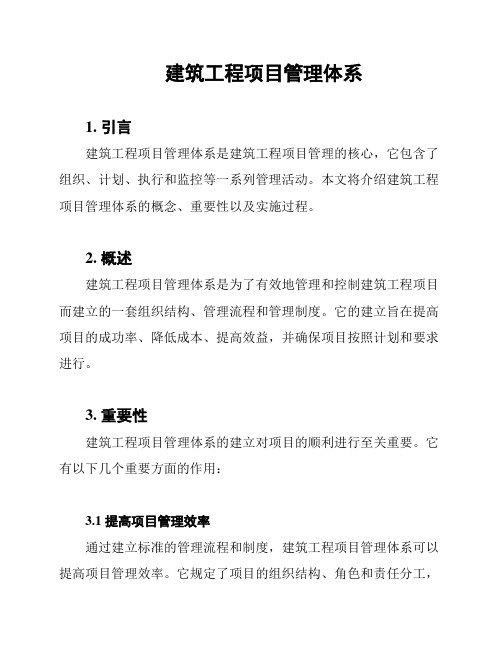
建筑工程项目管理体系1. 引言建筑工程项目管理体系是建筑工程项目管理的核心,它包含了组织、计划、执行和监控等一系列管理活动。
本文将介绍建筑工程项目管理体系的概念、重要性以及实施过程。
2. 概述建筑工程项目管理体系是为了有效地管理和控制建筑工程项目而建立的一套组织结构、管理流程和管理制度。
它的建立旨在提高项目的成功率、降低成本、提高效益,并确保项目按照计划和要求进行。
3. 重要性建筑工程项目管理体系的建立对项目的顺利进行至关重要。
它有以下几个重要方面的作用:3.1 提高项目管理效率通过建立标准的管理流程和制度,建筑工程项目管理体系可以提高项目管理效率。
它规定了项目的组织结构、角色和责任分工,确保各个环节的协调与配合,减少重复劳动和沟通成本,从而提高项目执行效率。
3.2 降低项目风险建筑工程项目管理体系通过制定规范和流程,可以有效地识别、评估和控制项目风险。
它包括项目风险管理、质量管理、安全管理等方面,确保项目在安全、质量和法律合规方面的要求得到满足,减少项目风险。
3.3 提高项目质量建筑工程项目管理体系通过规定项目的质量管理流程和要求,确保项目按照高标准的质量要求进行。
它包括质量控制、验收评估、质量改进等方面,提高了项目的质量,增加了项目的竞争力。
3.4 提升项目管理能力建筑工程项目管理体系通过规范和流程的建立,提升了项目管理的专业化水平和能力。
它为项目管理人员提供了清晰的指导和参考,促进了项目管理人员的培训和发展,提升了整个团队的项目管理能力。
4. 建立过程建立建筑工程项目管理体系需要以下几个步骤:4.1 规划与准备在建立之前,需要进行规划和准备工作。
确定项目管理体系的目标和范围,明确所需资源和投入,制定建设方案和时间计划。
4.2 设计与实施在规划和准备工作完成后,开始进行设计和实施阶段。
设计项目管理体系的组织结构、流程和制度,制定相关文件和表格,进行培训和沟通。
4.3 验证与监控项目管理体系的设立需要经过验证和监控。
建筑智能化公司项目管理制度

建筑智能化公司项目管理制度一、项目管理概述项目管理是指对建筑智能化公司项目实施过程进行规划、组织、计划和控制的活动,以实现项目目标并达到客户满意度的要求。
二、项目管理组织架构1.项目管理部门:建立专门的项目管理部门负责统筹项目的计划与实施,包括项目经理、项目策划师、项目工程师等职位,确保项目能够按时按质完成。
2.项目组:根据项目规模和复杂程度,成立相应的项目组,由项目经理领导,包括技术人员、设计人员、工程师等,负责具体的项目实施工作。
三、项目管理流程1.项目启动:确定项目目标、项目范围、项目时间、项目质量和项目成本等关键要素,制定项目启动计划,并完成项目启动报告的编制。
2.项目策划:编制项目计划书,包括项目整体计划、项目工期计划、项目人力资源计划、项目成本计划等,明确项目阶段目标和任务,并编制相应的项目策划报告。
3.项目实施:根据项目计划,组织项目实施进度,进行项目资源调配,确保项目按计划进行,同时及时进行工程进展的跟踪与控制,及时处理项目风险、问题和变更。
4.项目评审:在项目关键节点或阶段,进行项目评审,评估项目实施效果,并根据评审结果进行调整和改进。
5.项目总结:项目完成后,进行项目总结,分析项目实施过程中的问题和经验,为以后类似项目提供参考。
四、项目管理规范1.项目目标明确:在项目启动阶段,明确项目目标,包括项目的技术要求、质量要求、成本要求和安全要求等。
2.项目计划合理:在项目策划阶段,制定合理的项目计划,确保项目目标能够按时按质完成。
3.项目沟通协调:项目组内部通过定期的例会和沟通,加强项目组的协调配合,确保项目进展顺利。
4.项目风险控制:在项目实施过程中,及时识别和评估项目风险,并采取措施进行控制和应对,以保证项目的顺利进行。
5.项目质量管理:在项目实施过程中,坚持全过程质量控制,建立完善的质量检查和验收制度,确保项目的质量符合要求。
6.项目问题解决:及时处置和解决项目中出现的问题,包括技术问题、施工问题和协调问题等。
建筑工程项目管理概论10
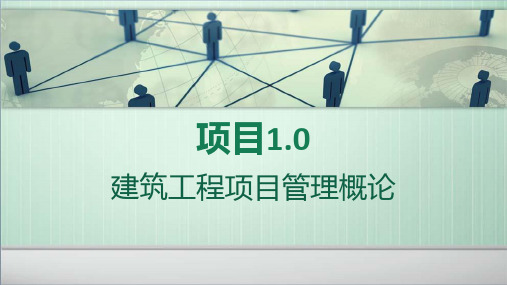
8.3.1 工程项目的保修
• 工程项目保修做法的步骤有哪些? ①发送保修书(或称《房屋保修卡》) ②要求检查和修理 ③验收
8.3.1 工程项目的保修
• 简述工程项目保修的经济责任。 ①施工单位未按国家有关规范、标准和设计要求施工,造成的质量 缺陷,由施工单位负责返修并承担经济责任。
②由于设计方面造成质量缺陷,由设计单位承担经济责任。由施工 单位负责维修,其费用按有关规定通过建设单位向设计单位索赔, 不足部分由建设单位负责。
进行施工项目 的目标管理
劳动要素管理 和施工现场管
理
施工项目的组 织协调
1.1.2 业主方项目管理(建设监理)
• 业主方的项目管理是全过程、全方位的,包括项目实施的各个阶 段,主要有组织协调、合同管理、信息管理,投资、质量、安全 四大目标控制。(一协调二管理四控制)
8.1.5 竣工验收的组织
• 竣工验收组织的职责是什么? ①制定竣工验收工作计划 ②审查各种交工技术资料 ③审查工程决算 ④按验收规范对工程质量进行鉴定 ⑤负责试生产的监督与效果评定 ⑥签发工程项目竣工验收证书 ⑦对遗留问题做出处理和解决 ⑧提出竣工验收总结报告
8.1.6 竣工资料的移交
• 技术资料主要包括哪几个方面 ①土建方面 ②安装方面 ③建设单位和设计单位方面
8.2.3 工程项目管理考核与评价
• 考核评价的定量指标 ①工程质量指标 ②工程成本指标 ③工期指标 ④安全指标
8.2.3 工程项目管理考核与评价
• 考核评价的定性指标 ①执行企业各项制度的情况
②项目管理资料的收集、整理 情况
③思想工作方法与效果
④发包人及用户的评价
⑤在项目管理中应用的新技术 、新材料、新设备、新工艺的情 况
建筑工程项目管理教案
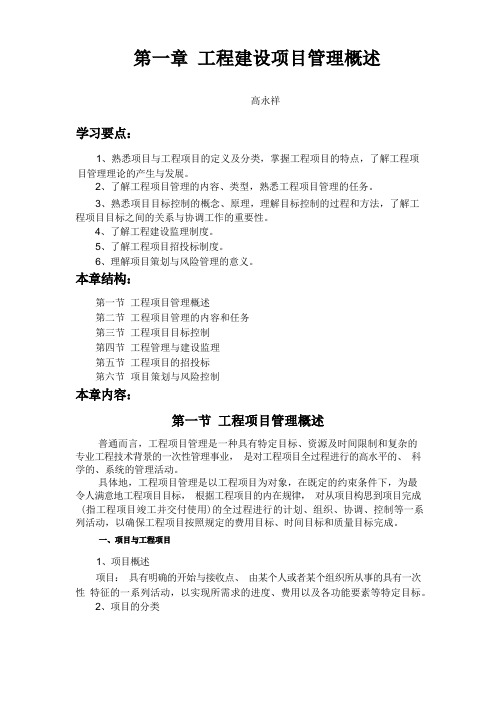
高永祥1、熟悉项目与工程项目的定义及分类,掌握工程项目的特点,了解工程项目管理理论的产生与发展。
2、了解工程项目管理的内容、类型,熟悉工程项目管理的任务。
3、熟悉项目目标控制的概念、原理,理解目标控制的过程和方法,了解工程项目目标之间的关系与协调工作的重要性。
4、了解工程建设监理制度。
5、了解工程项目招投标制度。
6、理解项目策划与风险管理的意义。
第一节工程项目管理概述第二节工程项目管理的内容和任务第三节工程项目目标控制第四节工程管理与建设监理第五节工程项目的招投标第六节项目策划与风险控制普通而言,工程项目管理是一种具有特定目标、资源及时间限制和复杂的专业工程技术背景的一次性管理事业,是对工程项目全过程进行的高水平的、科学的、系统的管理活动。
具体地,工程项目管理是以工程项目为对象,在既定的约束条件下,为最令人满意地工程项目目标,根据工程项目的内在规律,对从项目构思到项目完成 (指工程项目竣工并交付使用)的全过程进行的计划、组织、协调、控制等一系列活动,以确保工程项目按照规定的费用目标、时间目标和质量目标完成。
1、项目概述项目:具有明确的开始与接收点、由某个人或者某个组织所从事的具有一次性特征的一系列活动,以实现所需求的进度、费用以及各功能要素等特定目标。
2、项目的分类1 按项目规模分类:大型项目、中型项目、小型项目。
2 按项目的复杂程度分类:复杂项目、简单项目。
3 按项目的结果分类:产品、服务。
4 按行业分类:农业、工业、投资、建设、科研项目等。
5 按项目用户状况分类:有明确用户项目、无明确用户项目。
3、工程项目概述工程项目:为达到预期的目标,投入一定量的资本,在一定的约束条件下,经过决策与实施的必要程序形成固定资产的一次性事业。
工程项目具有如下特点:1 目标的约束性2 周期长风险大3 特殊的组织和法律条件4 复杂性和系统性4、工程项目分类1)按投资的再生产性质划分基本建设项目:新建、扩建、改建、迁建、重建项目等。
建筑工程项目管理是什么,如何进行项目管理
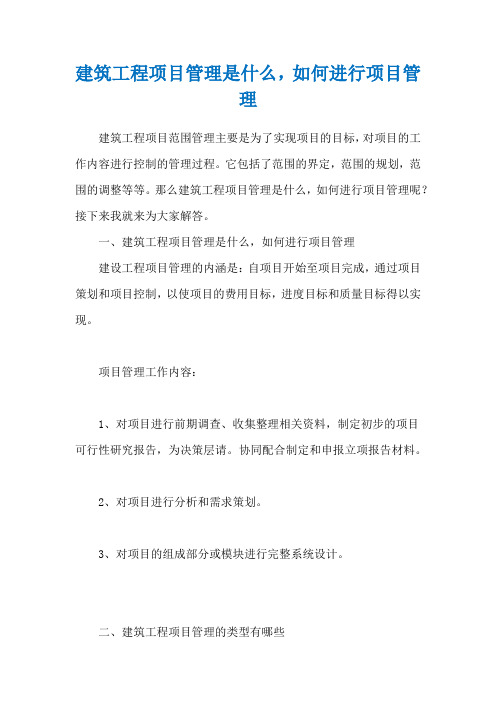
建筑工程项目管理是什么,如何进行项目管理建筑工程项目范围管理主要是为了实现项目的目标,对项目的工作内容进行控制的管理过程。
它包括了范围的界定,范围的规划,范围的调整等等。
那么建筑工程项目管理是什么,如何进行项目管理呢?接下来我就来为大家解答。
一、建筑工程项目管理是什么,如何进行项目管理建设工程项目管理的内涵是:自项目开始至项目完成,通过项目策划和项目控制,以使项目的费用目标,进度目标和质量目标得以实现。
项目管理工作内容:1、对项目进行前期调查、收集整理相关资料,制定初步的项目可行性研究报告,为决策层请。
协同配合制定和申报立项报告材料。
2、对项目进行分析和需求策划。
3、对项目的组成部分或模块进行完整系统设计。
二、建筑工程项目管理的类型有哪些按建设工程生产组织的特点,一个项目往往由众多参与单位承担不同的建设任务,而各参与单位的工作性质,工作任务和利益不同,因此形成了以下不同的建设工程项目管理类型:1、业主方的项目管理(它是建设工程项目管理的核心,是建设工程项目生产的总组织者)。
2、设计方的项目管理。
3、施工方的项目管理。
4、供货方的项目管理。
5、建设项目工程总承包方的项目管理。
6、其他建设工程项目管理。
法律依据:《建设工程项目管理试行办法》第三条项目管理企业应当具有工程勘察、设计、施工、监理、造价学习、招标代理等一项或多项资质。
工程勘察、设计、施工、监理、造价学习、招标代理等企业可以在本企业资质以外申请其他资质。
企业申请资质时,其原有工程业绩、技术人员、管理人员、注册资金和办公场所等资质条件可合并考核。
第四条从事工程项目管理的专业技术人员,应当具有城市规划师、建筑师、工程师、建造师、监理工程师、造价工程师等一项或者多项执业资格。
取得城市规划师、建筑师、工程师、建造师、监理工程师、造价工程师等执业资格的专业技术人员,可在工程勘察、设计、施工、监理、造价学习、招标代理等任何一家企业申请注册并执业。
以上就是我为大家解答的关于建筑工程项目管理是什么,如何进行项目管理问题的相关法律知识内容了,综上所述呢,我们可以了解到建设工程项目管理的内涵是:自项目开始至项目完成,通过项目策划和项目控制,以使项目的费用目标,进度目标和质量目标得以实现。
一级建造师建筑工程项目管理
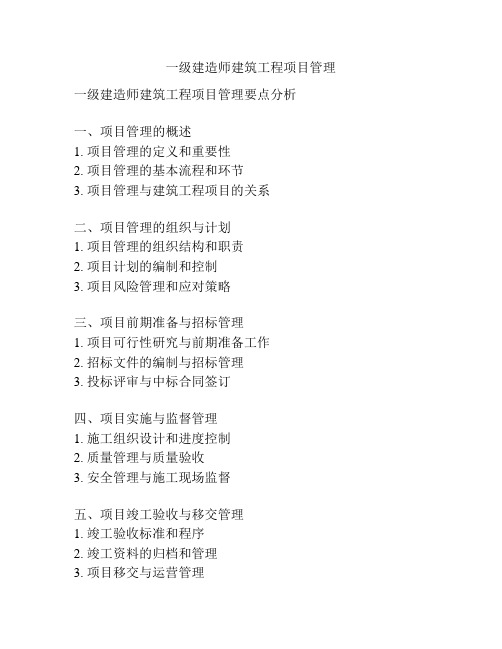
一级建造师建筑工程项目管理一级建造师建筑工程项目管理要点分析
一、项目管理的概述
1. 项目管理的定义和重要性
2. 项目管理的基本流程和环节
3. 项目管理与建筑工程项目的关系
二、项目管理的组织与计划
1. 项目管理的组织结构和职责
2. 项目计划的编制和控制
3. 项目风险管理和应对策略
三、项目前期准备与招标管理
1. 项目可行性研究与前期准备工作
2. 招标文件的编制与招标管理
3. 投标评审与中标合同签订
四、项目实施与监督管理
1. 施工组织设计和进度控制
2. 质量管理与质量验收
3. 安全管理与施工现场监督
五、项目竣工验收与移交管理
1. 竣工验收标准和程序
2. 竣工资料的归档和管理
3. 项目移交与运营管理
六、项目管理的经验总结与问题分析
1. 项目管理的成功案例分析
2. 项目管理中常见问题及解决方法
3. 项目管理的改进与创新
七、一级建造师建筑工程项目管理的职业素质要求
1. 项目管理人员的专业知识与技能
2. 项目管理人员的沟通与协调能力
3. 项目管理人员的领导与决策能力
八、结语
以上是一级建造师建筑工程项目管理的要点分析,通过对项目管理的概述、组织与计划、前期准备与招标管理、实施与监督管理、竣工验收与移交管理等方面的详细分析,可以帮助项目管理人员更好地进行工程项目管理工作,并提升其职业素质和能力。
同时,经验总结和问题分析可以为项目管理实践提供借鉴和指导。
《建筑工程项目管理》教案
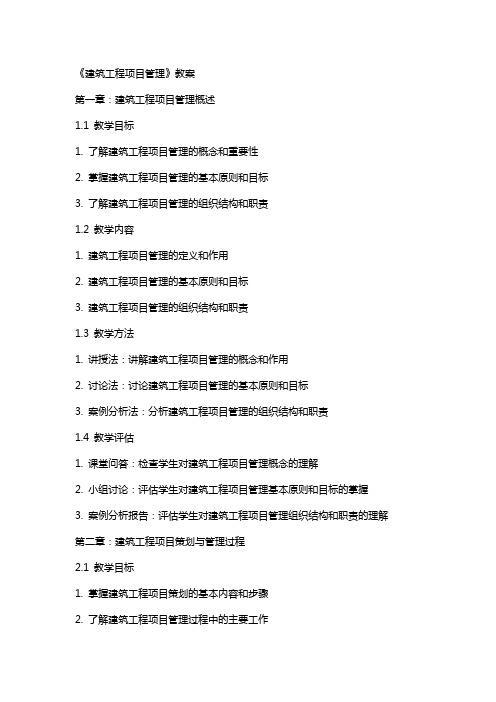
《建筑工程项目管理》教案第一章:建筑工程项目管理概述1.1 教学目标1. 了解建筑工程项目管理的概念和重要性2. 掌握建筑工程项目管理的基本原则和目标3. 了解建筑工程项目管理的组织结构和职责1.2 教学内容1. 建筑工程项目管理的定义和作用2. 建筑工程项目管理的基本原则和目标3. 建筑工程项目管理的组织结构和职责1.3 教学方法1. 讲授法:讲解建筑工程项目管理的概念和作用2. 讨论法:讨论建筑工程项目管理的基本原则和目标3. 案例分析法:分析建筑工程项目管理的组织结构和职责1.4 教学评估1. 课堂问答:检查学生对建筑工程项目管理概念的理解2. 小组讨论:评估学生对建筑工程项目管理基本原则和目标的掌握3. 案例分析报告:评估学生对建筑工程项目管理组织结构和职责的理解第二章:建筑工程项目策划与管理过程2.1 教学目标1. 掌握建筑工程项目策划的基本内容和步骤2. 了解建筑工程项目管理过程中的主要工作3. 掌握建筑工程项目管理的计划、组织、实施和控制方法2.2 教学内容1. 建筑工程项目策划的基本内容和步骤2. 建筑工程项目管理过程中的主要工作3. 建筑工程项目管理的计划、组织、实施和控制方法2.3 教学方法1. 讲授法:讲解建筑工程项目策划的基本内容和步骤2. 案例分析法:分析建筑工程项目管理过程中的主要工作3. 小组讨论法:讨论建筑工程项目管理的计划、组织、实施和控制方法2.4 教学评估1. 课堂问答:检查学生对建筑工程项目策划的理解2. 案例分析报告:评估学生对建筑工程项目管理过程中的主要工作的理解3. 小组报告:评估学生对建筑工程项目管理的计划、组织、实施和控制方法的掌握第三章:建筑工程项目组织与管理团队3.1 教学目标1. 了解建筑工程项目组织的结构和类型2. 掌握建筑工程项目管理团队的构建和管理方法3. 了解建筑工程项目组织与管理的协调和沟通技巧3.2 教学内容1. 建筑工程项目组织的结构和类型2. 建筑工程项目管理团队的构建和管理方法3. 建筑工程项目组织与管理的协调和沟通技巧3.3 教学方法1. 讲授法:讲解建筑工程项目组织的结构和类型2. 案例分析法:分析建筑工程项目管理团队的构建和管理方法3. 角色扮演法:训练学生建筑工程项目组织与管理的协调和沟通技巧3.4 教学评估1. 课堂问答:检查学生对建筑工程项目组织的结构的理解2. 案例分析报告:评估学生对建筑工程项目管理团队的构建和管理方法的掌握3. 角色扮演评估:评估学生对建筑工程项目组织与管理的协调和沟通技巧的掌握第四章:建筑工程项目计划与控制4.1 教学目标1. 掌握建筑工程项目计划的类型和编制方法2. 了解建筑工程项目控制的基本原则和手段3. 掌握建筑工程项目进度控制和成本控制的方法4.2 教学内容1. 建筑工程项目计划的类型和编制方法2. 建筑工程项目控制的基本原则和手段3. 建筑工程项目进度控制和成本控制的方法4.3 教学方法1. 讲授法:讲解建筑工程项目计划的类型和编制方法2. 案例分析法:分析建筑工程项目控制的基本原则和手段3. 小组讨论法:讨论建筑工程项目进度控制和成本控制的方法4.4 教学评估1. 课堂问答:检查学生对建筑工程项目计划的类型的理解2. 案例分析报告:评估学生对建筑工程项目控制的基本原则和手段的掌握3. 小组报告:评估学生对建筑工程项目进度控制和成本控制的方法的掌握第五章:建筑工程项目风险管理5.1 教学目标1. 了解建筑工程项目风险的概念和分类2. 掌握建筑工程项目风险识别和评估的方法3. 了解建筑工程项目风险应对和管理的策略5.2 教学内容1. 建筑工程项目风险的概念和分类2. 建筑工程项目风险识别和评估的方法3. 建筑工程项目风险应对和管理的策略5.3 教学方法1. 讲授法:讲解建筑工程项目风险的概念和分类2. 案例分析法:分析建筑工程项目风险识别和评估的方法3. 小组讨论法:讨论建筑工程项目风险应对和管理的策略5.4 教学评估1. 课堂问答:检查学生对建筑工程项目风险的概念的理解2.第六章:建筑工程项目质量管理6.1 教学目标1. 理解建筑工程项目质量管理的原则和体系2. 掌握建筑工程项目质量计划编制和实施的方法3. 了解建筑工程项目质量控制和验收的标准6.2 教学内容1. 建筑工程项目质量管理的原则和体系2. 建筑工程项目质量计划编制和实施的方法3. 建筑工程项目质量控制和验收的标准6.3 教学方法1. 讲授法:讲解建筑工程项目质量管理的原则和体系2. 案例分析法:分析建筑工程项目质量计划编制和实施的方法3. 小组讨论法:讨论建筑工程项目质量控制和验收的标准6.4 教学评估1. 课堂问答:检查学生对建筑工程项目质量管理原则的理解2. 案例分析报告:评估学生对建筑工程项目质量计划编制和实施方法的掌握3. 小组报告:评估学生对建筑工程项目质量控制和验收标准的理解第七章:建筑工程项目成本管理7.1 教学目标1. 理解建筑工程项目成本管理的基本原则和方法2. 掌握建筑工程项目成本估算、预算和控制的技巧3. 了解建筑工程项目成本分析和报告的编写7.2 教学内容1. 建筑工程项目成本管理的基本原则和方法2. 建筑工程项目成本估算、预算和控制的技巧3. 建筑工程项目成本分析和报告的编写7.3 教学方法1. 讲授法:讲解建筑工程项目成本管理的基本原则和方法2. 案例分析法:分析建筑工程项目成本估算、预算和控制的技巧3. 小组讨论法:讨论建筑工程项目成本分析和报告的编写7.4 教学评估1. 课堂问答:检查学生对建筑工程项目成本管理原则的理解2. 案例分析报告:评估学生对建筑工程项目成本估算、预算和控制技巧的掌握3. 小组报告:评估学生对建筑工程项目成本分析和报告编写的理解第八章:建筑工程项目合同管理8.1 教学目标1. 理解建筑工程项目合同管理的重要性和原则2. 掌握建筑工程项目合同的类型、内容和编制方法3. 了解建筑工程项目合同的履行、变更和解除的方法8.2 教学内容1. 建筑工程项目合同管理的重要性和原则2. 建筑工程项目合同的类型、内容和编制方法3. 建筑工程项目合同的履行、变更和解除的方法8.3 教学方法1. 讲授法:讲解建筑工程项目合同管理的重要性和原则2. 案例分析法:分析建筑工程项目合同的类型、内容和编制方法3. 小组讨论法:讨论建筑工程项目合同的履行、变更和解除的方法8.4 教学评估1. 课堂问答:检查学生对建筑工程项目合同管理重要性的理解2. 案例分析报告:评估学生对建筑工程项目合同类型、内容和编制方法的掌握3. 小组报告:评估学生对建筑工程项目合同履行、变更和解除方法的掌握第九章:建筑工程项目信息技术管理9.1 教学目标1. 理解建筑工程项目信息技术管理的作用和重要性2. 掌握建筑工程项目信息技术的应用和管理方法3. 了解建筑工程项目信息管理系统的设计和实施9.2 教学内容1. 建筑工程项目信息技术管理的作用和重要性2. 建筑工程项目信息技术的应用和管理方法3. 建筑工程项目信息管理系统的设计和实施9.3 教学方法1. 讲授法:讲解建筑工程项目信息技术管理的作用和重要性2. 案例分析法:分析建筑工程项目信息技术的应用和管理方法3. 小组讨论法:讨论建筑工程项目信息管理系统的设计和实施9.4 教学评估1. 课堂问答:检查学生对建筑工程项目信息技术管理作用的的理解2. 案例分析报告:评估学生对建筑工程项目信息技术的应用和管理方法的掌握3. 小组报告:评估学生对建筑工程项目信息管理系统设计和实施的理解第十章:建筑工程项目绿色管理10.1 教学目标1. 理解建筑工程项目绿色管理的原则和目标2. 掌握建筑工程项目绿色设计和管理的方法3. 了解建筑工程项目绿色施工和评价的标准10.2 教学内容1. 建筑工程项目绿色管理的原则和目标2. 建筑工程项目绿色设计和管理的方法3. 建筑工程项目绿色施工和评价的标准10.3 教学方法1. 讲授法:讲解建筑工程项目绿色管理的原则和目标2. 案例分析法:分析建筑工程项目绿色设计和管理的方法3. 小组讨论法:讨论建筑工程项目绿色施工和评价的标准10.4 教学评估1. 课堂第十一章:建筑工程项目安全管理11.1 教学目标1. 理解建筑工程项目安全管理的重要性2. 掌握建筑工程项目安全计划编制和实施的方法3. 了解建筑工程项目安全控制和事故处理的标准11.2 教学内容1. 建筑工程项目安全管理的原则和体系2. 建筑工程项目安全计划编制和实施的方法3. 建筑工程项目安全控制和事故处理的标准11.3 教学方法1. 讲授法:讲解建筑工程项目安全管理的原则和体系2. 案例分析法:分析建筑工程项目安全计划编制和实施的方法3. 小组讨论法:讨论建筑工程项目安全控制和事故处理的标准11.4 教学评估1. 课堂问答:检查学生对建筑工程项目安全管理原则的理解2. 案例分析报告:评估学生对建筑工程项目安全计划编制和实施方法的掌握3. 小组报告:评估学生对建筑工程项目安全控制和事故处理标准的理解第十二章:建筑工程项目沟通与协调12.1 教学目标1. 理解建筑工程项目沟通与协调的重要性2. 掌握建筑工程项目沟通与协调的方法和技巧3. 了解建筑工程项目沟通与协调的工具和应用12.2 教学内容1. 建筑工程项目沟通与协调的原则和体系2. 建筑工程项目沟通与协调的方法和技巧3. 建筑工程项目沟通与协调的工具和应用12.3 教学方法1. 讲授法:讲解建筑工程项目沟通与协调的原则和体系2. 案例分析法:分析建筑工程项目沟通与协调的方法和技巧3. 小组讨论法:讨论建筑工程项目沟通与协调的工具和应用12.4 教学评估1. 课堂问答:检查学生对建筑工程项目沟通与协调原则的理解2. 案例分析报告:评估学生对建筑工程项目沟通与协调方法和技巧的掌握3. 小组报告:评估学生对建筑工程项目沟通与协调工具和应用的理解第十三章:建筑工程项目收尾管理13.1 教学目标1. 理解建筑工程项目收尾管理的重要性2. 掌握建筑工程项目收尾管理的程序和方法3. 了解建筑工程项目收尾管理的注意事项13.2 教学内容1. 建筑工程项目收尾管理的原则和体系2. 建筑工程项目收尾管理的程序和方法3. 建筑工程项目收尾管理的注意事项13.3 教学方法1. 讲授法:讲解建筑工程项目收尾管理的原则和体系2. 案例分析法:分析建筑工程项目收尾管理的程序和方法3. 小组讨论法:讨论建筑工程项目收尾管理的注意事项13.4 教学评估1. 课堂问答:检查学生对建筑工程项目收尾管理原则的理解2. 案例分析报告:评估学生对建筑工程项目收尾管理程序和方法的掌握3. 小组报告:评估学生对建筑工程项目收尾管理注意事项的理解第十四章:建筑工程项目伦理与合规管理14.1 教学目标1. 理解建筑工程项目伦理与合规管理的重要性2. 掌握建筑工程项目伦理与合规管理的方法和技巧3. 了解建筑工程项目伦理与合规管理的要求和标准14.2 教学内容1. 建筑工程项目伦理与合规管理的原则和体系2. 建筑工程项目伦理与合规管理的方法和技巧3. 建筑工程项目伦理与合规管理的要求和标准14.3 教学方法1. 讲授法:讲解建筑工程项目伦理与合规管理的原则和体系2. 案例分析法:分析建筑工程项目伦理与合规管理的方法和技巧3. 小组讨论法:讨论建筑工程项目伦理与合规管理的要求和标准14.4 教学评估1. 课堂问答:检查学生对建筑工程项目伦理与合规管理原则的理解2. 案例分析报告:评估学生对建筑工程项目伦理与合规管理方法和技巧的掌握3. 小组报告:评估学生对建筑工程项目伦理与合规管理要求和标准的理解第十五章:建筑工程项目案例分析与实战演练15.1 教学目标1. 培养学生对建筑工程项目管理的综合运用能力2. 加深学生对建筑工程项目管理各个环节的理解3. 提高学生解决实际问题的能力和团队协作能力15.2 教学内容1. 建筑工程项目案例分析2. 建筑工程项目管理实战演练15.3 教学方法1. 案例分析法:分析建筑工程项目管理的实际案例2. 小组讨论法:讨论案例中的问题和解决方案3. 实战演练法:进行建筑工程项目管理的模拟实战15重点和难点解析本文档为您提供了一份完整的《建筑工程项目管理》教案,涵盖了建筑工程项目管理的基本概念、原则、目标、组织结构和职责、计划与控制、风险管理、质量管理、成本管理、合同管理、信息技术管理、安全管理、沟通与协调、收尾管理、伦理与合规管理以及案例分析与实战演练等十五个章节的内容。
建筑工程项目投资管理
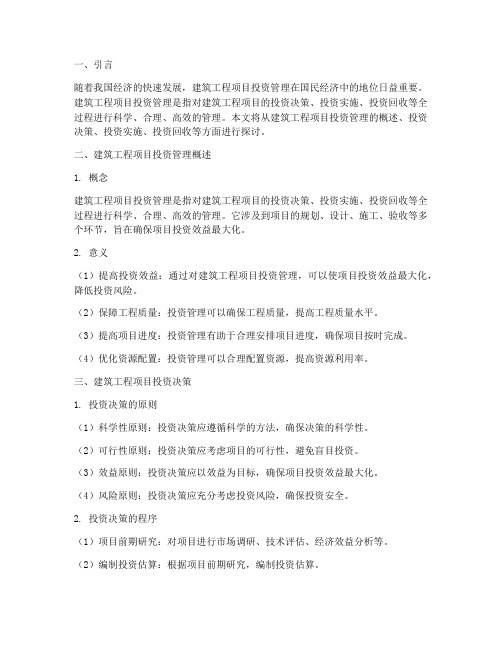
一、引言随着我国经济的快速发展,建筑工程项目投资管理在国民经济中的地位日益重要。
建筑工程项目投资管理是指对建筑工程项目的投资决策、投资实施、投资回收等全过程进行科学、合理、高效的管理。
本文将从建筑工程项目投资管理的概述、投资决策、投资实施、投资回收等方面进行探讨。
二、建筑工程项目投资管理概述1. 概念建筑工程项目投资管理是指对建筑工程项目的投资决策、投资实施、投资回收等全过程进行科学、合理、高效的管理。
它涉及到项目的规划、设计、施工、验收等多个环节,旨在确保项目投资效益最大化。
2. 意义(1)提高投资效益:通过对建筑工程项目投资管理,可以使项目投资效益最大化,降低投资风险。
(2)保障工程质量:投资管理可以确保工程质量,提高工程质量水平。
(3)提高项目进度:投资管理有助于合理安排项目进度,确保项目按时完成。
(4)优化资源配置:投资管理可以合理配置资源,提高资源利用率。
三、建筑工程项目投资决策1. 投资决策的原则(1)科学性原则:投资决策应遵循科学的方法,确保决策的科学性。
(2)可行性原则:投资决策应考虑项目的可行性,避免盲目投资。
(3)效益原则:投资决策应以效益为目标,确保项目投资效益最大化。
(4)风险原则:投资决策应充分考虑投资风险,确保投资安全。
2. 投资决策的程序(1)项目前期研究:对项目进行市场调研、技术评估、经济效益分析等。
(2)编制投资估算:根据项目前期研究,编制投资估算。
(3)投资决策:根据投资估算,对项目进行投资决策。
(4)项目审批:将投资决策报相关部门审批。
四、建筑工程项目投资实施1. 项目前期准备(1)工程设计:根据投资决策,进行工程设计。
(2)招投标:按照招投标法,进行招投标工作。
(3)合同签订:与中标单位签订合同。
2. 项目施工(1)施工组织设计:根据工程设计,编制施工组织设计。
(2)施工管理:对施工过程进行严格管理,确保工程质量、进度、安全。
(3)合同管理:对合同执行情况进行跟踪,确保合同履行。
建设工程项目管理概述

主要在建设阶段。 ●工程设计项目—其重点在设计阶段,由设计单位从事的工程项目活动,具体范
围也随业主要求而变化。 ●工程监理项目—监理作为建设工程项目中的特殊参与方,受业主的委托在工程
结合一个典型的建设工程项目,分析其处在项目实施的哪个阶段及其管理内容. 讨论项目管理与一般管理的差异性分析如何才能使得项目管理走向成功。
4
通常规模大、技术复杂。业主通常会高度参与工程项目的开发,而且业主喜
欢用设计—建造的发包方式来缩短整个工期。
●基础设施和重工业建筑(高速公路、隧道、桥梁、管道、排水系统等)
大多属于公共工程项目。豆浆渠道来源于政府的税收、各类基金等。特点:
是以高度的机械化来代替劳动力密集的手工操作。
2、从不同角度进行的,其他的分类形式:
按投资者登记注册类别分-—国有、集体、股份合作、联营、有限责任公司、股
份有限公司、港澳台商、外商、个人等投资的建设
工程项目;
按我国现行计划管理体制分—-基本建设、更新改造、房地产开发投资、其他固
定资产投资等项目;
按奖金的来源分——国家预算类资金、国内贷款、利用外资、自筹资金等投资的
建设工程项目;
按建设工程项目隶属关系分——中央项目、地方项目;
建设工程项目基本特征:
建设工程项目具有项目的基本特征 + 其独有的项目特征
一次性
建设工程项目投资大
约束性
建设周期长
目标性
+ 不确定性因素多、风险大
寿命的周期性
项目参与人员多
活动的多样性
建设工程项目的项目管理极其重要
- 1、下载文档前请自行甄别文档内容的完整性,平台不提供额外的编辑、内容补充、找答案等附加服务。
- 2、"仅部分预览"的文档,不可在线预览部分如存在完整性等问题,可反馈申请退款(可完整预览的文档不适用该条件!)。
- 3、如文档侵犯您的权益,请联系客服反馈,我们会尽快为您处理(人工客服工作时间:9:00-18:30)。
Different categories of involvement
• Project Sponsor – The client or organisation representative who is tasked with championing the project and leading it to a successful conclusion. • Stakeholders – who will support or be affected by your project. • Interested Parties – A observer; someone interested but without much influence. • End Users – sometimes these can also be Stakeholders or Interested Parties. • Project Team Members – Those people whose skills are required to actually implement and undertake the project.
Stakeholders – they‟re only human
Rational Social Personal Motivational
• Historical • Commercial objectives • Price/ Schedule/ Performance • Other stakeholders that influence them • e.g. their board, CFO, customers, etc., • Your competitors • The media
Iterate Agree
• Incorporate concerns in changes • Present back • Encourage ownership
• The approach and impact • Commitment to make it happen
The Workhouse Case Study
•
•
•
Who are your stakeholders?
Staff/ team/ board
Competitors Investors/ shareholders
Family/ spouse
Alliances / partners Client executives
Client‟s customer
Engaging Stakeholders
Prepare Engage
• • • •
Identify Understand context Anticipate objectives Rehearse
• • • •
Ensure understanding Clarify objections Understand root causes Feedback
• Personal agendas • Emotional responses • Perceptions of your reputation • History and how “involved”, • Communication preferences
• What makes them „tick‟?
Stakeholder strategy
SCHEMERS SYNERGY ZEALOTS KEY ALLIES/ SUPPORTERS
WAVERERS
MUTINEER ANTAGONISM
Prioritisation of Stakeholders
support • Too much focus on outputs, not enough on outcomes • Bad communication between relevant parties • Difficulty overcoming resistance to change
D'Herbemont and Cesar (1998)
Introduction to Project Management
Week 2
Rebecca Allan
Learning Objectives Week 2
• •
To understand who stakeholders are To recognise the key basic activities in stakeholder management To recognise different categories of involvement for stakeholders To appreciate the stakeholder power-interest grid To understand the benefits of stakeholder mapping
•
•
•
Common causes of project failure
Human difficulties: • Unclear and lack of consensus on objectives • Insufficient senior management/political/end user
Stakeholder Management
Do - Consider carefully what “success” is … • Try to quantify/put a value on stakeholder attitudes
• Have a detailed stakeholder strategy (and adapt it) • Identify, map and profile the stakeholders (up-front & ongoing) • Consult overtly, efficiently, early; and listen • Expect some frustration, persist • Exploit the alliances • Take time to plan your moves / decisions • Communicate, communicate, communicate
What to avoid...
Don‟t … • Make too many assumptions (e.g. about information)
• Think that you will be able to please everyone • Be too re-active / change the plan too often • Forget that people behave emotionally, socially & rationally • Panic, give up, lose sight of the main objective • Think that what you say is the same as what they hear • Underestimate the complexity of the situation/system • Forget that fixing meetings, etc. takes time • Lose your sense of humour - they’re only humans
Tutorial
Fleming Park Parks & Leisure Development Case study
Keep Satisfied
Manage Closely
Monitor
Keep informed
The stakeholder power-interest grid
(Slack et al., 2008)
Stakeholder Map
Stakeholder Impact Importance Allegiance AIH LIH HIH MIH Concerns Actions Stakeholder Role View Influence AIH/LIH/ Concerns HIH/MIH Actions/ Strategy A Champion +2 High MIH B Sponsor +1 High HIH C User +1 Medium HIH D Adviser ? Medium HIH E ? 0 Low LIH F User -1 Low AIH G Blocker -2 Low AIH Key: AIH – Against it happening; LIH – Let it happen; HIH – Help it happen; MIH – Make it happen
Why are relationship skills important?
•
•
Increasing use of alliances / partnerships which are heavily relationship based Complexity of projects – large numbers of relationships with increasingly high level of uncertainty Increasing requirement for improved quality of relationships with customers Customers demand for people who understand their business Project success becoming more subjective
